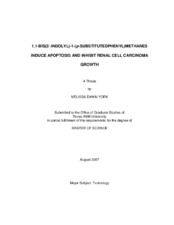| dc.description.abstract | Renal cell carcinoma (RCC) accounts for 85% of kidney cancer incidence in the US. Since 1950 there has been a 126% increase in kidney cancer incidence in the US. Thirty percent of new patients present with a localized easily treatable carcinoma while 30% of patients present with a high-grade metastatic carcinoma. Five-year survival rates for metastatic RCC is 6-12 months (Lipworth et al, 2006). Current disease treatment options for metastasis include chemotherapy and radiation (8% response rate), immunotherapy (15-30% response rate) and newly developed angiogenesis inhibitors which are in phase III trials (Staehler et el, 2005). In RCC cells, it has been shown that PPARγ agonists inhibit cell proliferation, induce apoptosis, and induce anti-angiogenic effects in vitro. Unlike most tumor types, PPARγ is downregulated in tissue samples from 47 RCC patients. However, in cell culture studies PPARγ expression does not correlate with growth inhibitory or apoptotic effects of PPARγ agonists in renal cell lines indicating that PPARγ independent responses may play a large role in actions associated with the PPARγ agonists (Yuan et al, 2006). 1,1-Bis(3'-indolyl)-1-(p-substitutedphenyl)methanes containing p-trifluoromethyl, p-t-butyl and p-phenyl substituents activate peroxisome proliferator-activated receptor (PPAR) and inhibit growth of ACHN and 786-0 renal cell carcinoma cell lines. PPAR is overexpressed in ACHN cells and barely detectable in 786-0 cells, and treatment with the t-butyl analog (DIM-C-pPhtBu) induces cell cyle inhibition. DIM-C-pPhtBu also induced several common PPAR-independent proapoptotic responses in ACHN and 786-0 cells, including increased expression of nonsteroidal antiimflammatory drug-activated gene-1 (NAG-1) and endoplasmic reticulum stress which activates death receptor 5 and the extrinsic pathway of apoptosis. In addition, DIM-C-pPhtbu (40 mg/kg/d) also inhibited tumor growth in an orthotopic mouse model for renal carcinogenesis, and this was accompanied by induction of apoptosis in renal tumors treated with DIM-C-pPhtBu but not in tumors treated with the corn oil vehicle (control). Thus, DIM-C-pPhtBu and related compounds represent a novel class of mechanism-based drugs that have potential for treatment of renal adenocarcinoma for which there are currently limited options for successful chemotherapy. | en |


